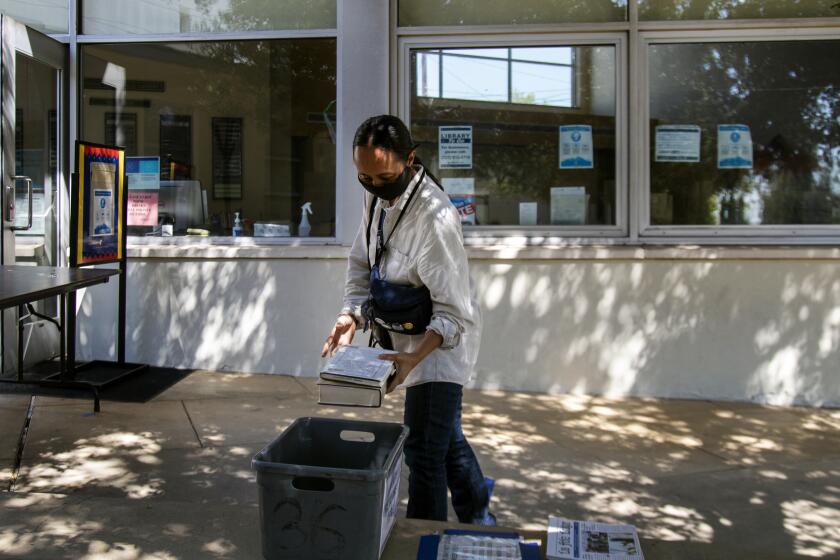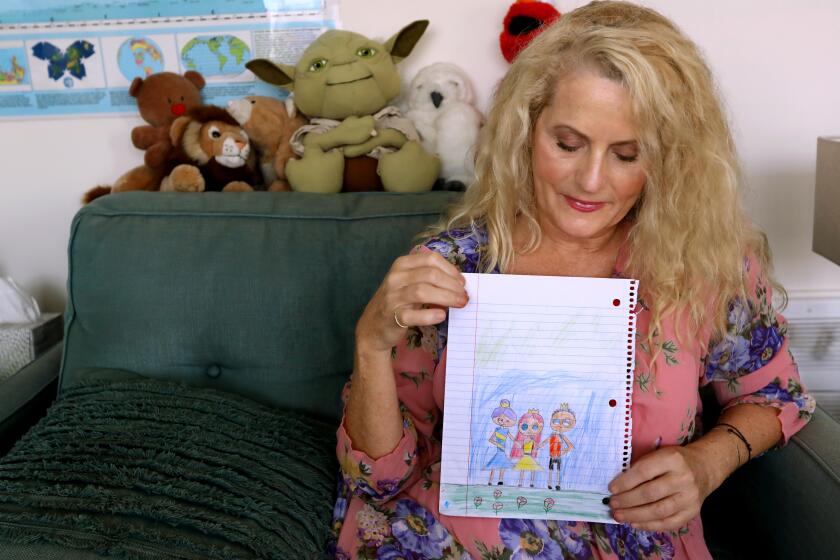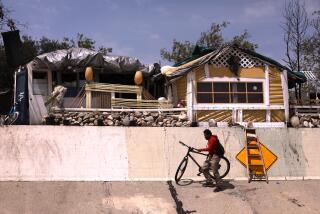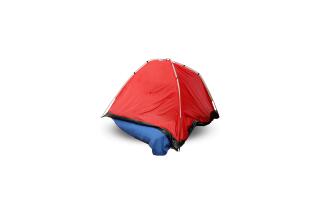Who has it harder than homeless people when the pandemic closes indoor spaces?
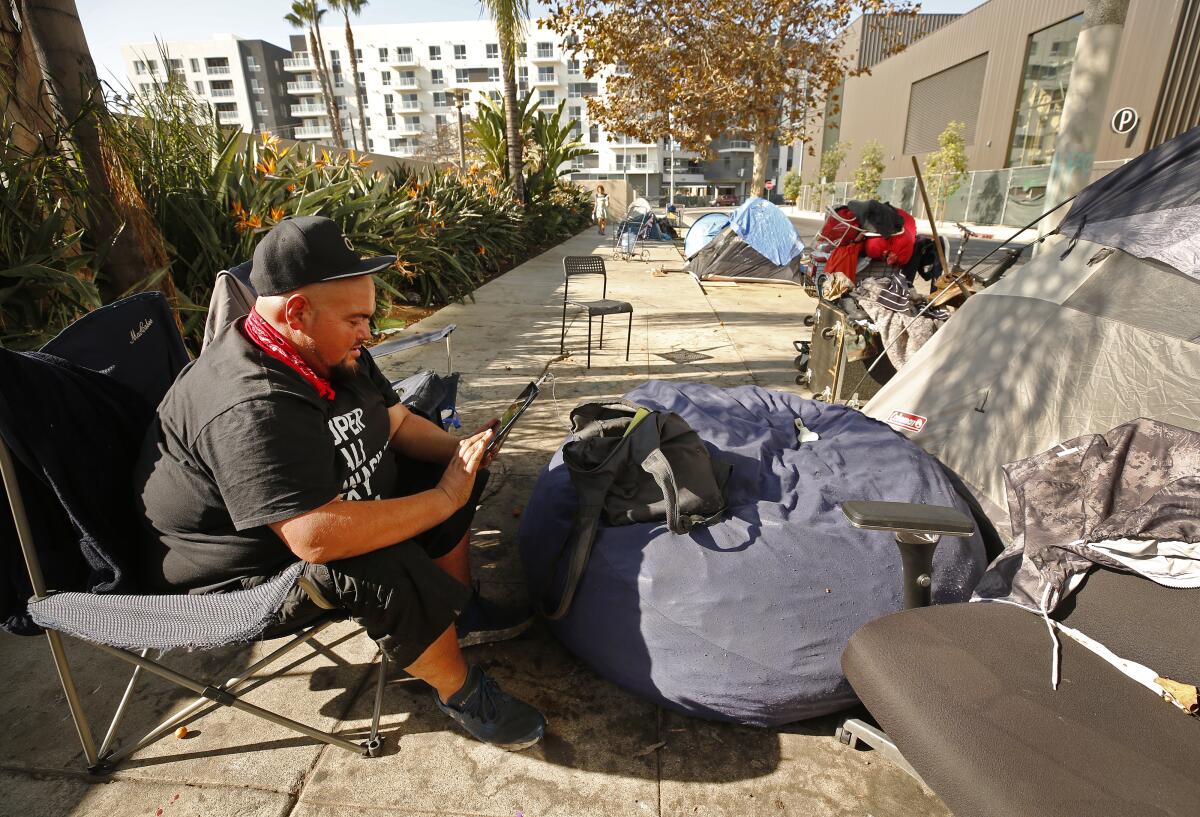
I have a roof over my head. I have heat. I have electricity. I have more than one bathroom to choose from. I have a kitchen full of food.
This past week, I set out to check up on people living on the streets of my Hollywood neighborhood because I couldn’t stop thinking about the extent of that privilege.
I couldn’t stop thinking in this time of Thanksgiving about how thankful I should be for my warm home, even if the COVID-19 pandemic sometimes makes me feel stir-crazy inside of it.
So many of us chafe right now at the inability because of pandemic restrictions to eat inside a restaurant or sip a coffee in a cafe or go browse the shelves of a public library.
But I couldn’t stop thinking about how much harder having such communal indoor spaces closed is on those of us who don’t have any indoors to call our own.
The people living on our streets used to be able to go inside public libraries and coffee shops to use bathrooms, to charge cellphones and hop on Wi-Fi, to find some respite from the harshness of living outside. Some got cheap gym memberships for ready access to showers, especially helpful when you have a job but no home.
Now temperatures are dropping and rainy days are ahead, and most of those options are unavailable — while shelter, as well as public toilets and hand-washing stations, remains in far too short supply.
P.J. Butters, 44, whose tent is clustered with others in a tight community on a block perpendicular to Vine Street, said he now sneaks into parking lots that have outlets to charge his phone and uses a bucket to clean up as best he can at a spigot he found in a nearby alley.
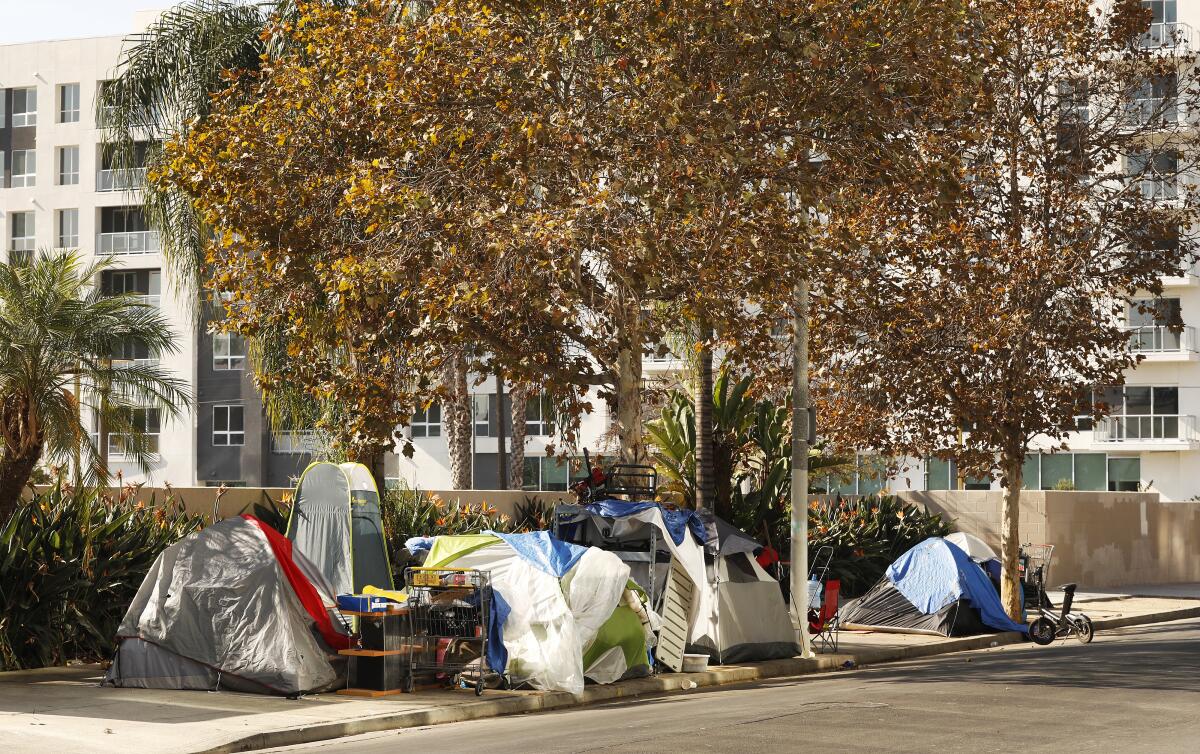
Tom Ponzo, 51, camping on a side street just north of Hollywood Boulevard, said nearby restaurants that are still open won’t let homeless people come inside to use their facilities. He can book appointments for showers at a church a few blocks away. But because there aren’t any public toilets close at hand, he and his unhoused neighbors often have to resort to bags and buckets when they need to go to the bathroom.
“Hopefully no one’s around when we do it. It’s embarrassing,” he told me.
These are people who also have to worry, as all of us do, about staying well in a deadly pandemic. But unlike many of us, they often can’t even easily wash their hands, and they have at best a thin membrane of tent to protect them from everyone else.
The Los Angeles Public Library’s buildings remain COVID-closed. But in the pandemic, librarians’ creativity has blossomed online and many new doors for patrons have opened.
My neighborhood always has more homeless people than most because it has more services available to them. Naturally, it’s helpful to camp near where you can get a helping hand.
But the already sizable number of people living on my neighborhood’s streets before the pandemic appears to my eye to have been growing steadily.
It’s a challenge for the rest of the neighborhood — the other residents, the business owners — who often vent their frustration when trash piles up at encampments and sidewalks are blocked by tents.
And there certainly are more tents. In some areas, they stretch, one after another, down the sidewalks of whole blocks and then around the corners onto other ones.
What I’ve come to understand though is that seeing more tents right now may be a good sign — because a lot of them have been handed out by outreach teams working as hard as they can to try to keep those who lack housing well. These teams are out daily checking on people, testing them, handing out sanitizer and masks, and distributing tents to allow for some semblance of Safer at Home sequestering even when home is the street.
If there is no bed or room available for someone who tests positive for the virus, “at least they can isolate in a tent,” said Nathan Sheets, director of the Center in Hollywood, a nonprofit with the aim of ending isolation and homelessness, which has been running one of the outreach teams with medical staff from the Saban Community Clinic.
Obviously, isolating in a tent is not ideal, he said, but it’s worth noting that L.A. mercifully has not had the high number of coronavirus cases in the homeless population that many people feared at the start of the pandemic.
Some of those who live on the streets of my neighborhood don’t even have tents. They stretch out on hard sidewalk under thin sheets or blankets. They build lean-tos out of cardboard boxes and black garbage bags and tarps. Right under the 101, a few blocks from my home, on a crumbly dirt slope that will turn to mud when it rains, someone has patched together a little privacy out of palm fronds and scraps of wood.
I find it awkward sometimes, by the way, to approach such a dwelling, to call out “hello” to a zipped-up tent or a shelter of strung-together tarps. Often I have to steel myself to so abruptly invade the space of someone who has few means to fend off that invasion.
I feel that vulnerability deeply when I see a padlocked tent because a padlock on the zipper of a mesh tent door clearly offers so little real protection.
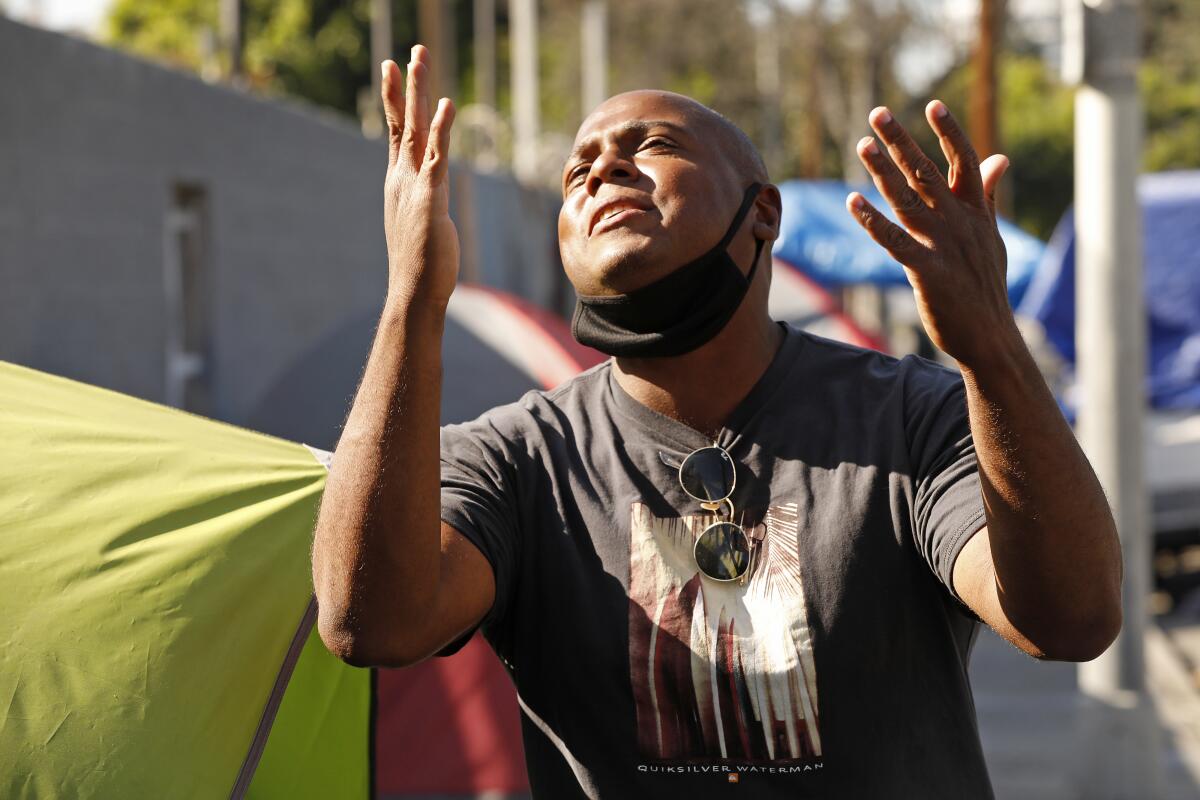
“That’s why you have to find yourself a good community out here,” said Ruben A. Colon, 37, whose immaculate encampment — with great views of the Hollywood sign and the Capitol Records building — I found a half-dozen blocks from my home. Colon prefers to refer to himself not as a homeless person but as an “urban pilgrim,” he told me. And he loves to read and learn and used to spend whole days, especially the rainy ones, in various libraries.
“I’d usually go online, read a book, charge up, hang out with some friends, keep it low,” he said. Now he walks the neighborhood, bundles up on colder days and picks up books to read at the Little Free Libraries he finds on residential streets.
When a little girl wound up in foster care, she got help to turn her life around. CASA, the program that provided it, needs many more volunteers.
I was expecting when I went out on the streets to ask people about how it feels to be unhoused during this time to hear that they felt more isolated than ever. Because this year, it’s not just that they can’t go sit in a Starbucks or a McDonald’s or spend a day in a library. Even the usual turkey dinners were to-go this week because the organizations that are dedicated to helping them often can’t easily welcome them safely inside.
The Center, for instance, normally would invite all comers onto its patio most weekdays for Coffee Hour. It’s meant to be a time for those living on the streets to be able to connect with others, to relax and feel a sense of community — and to start to get help if that’s what they want. These days, Sheets told me, more and more people are “showing up at our gates with complicated and complex needs. Some have lost their incomes and are living out of their cars or maybe they’re still precariously housed but they don’t have enough money for food.”
There’s no easy way, though, to set up the patio safely during the pandemic, when the staff is trying to serve a large number of people. So people line up outside the gate, blocked by a table, where gloved and masked staffers use a box to pass them cups of coffee, food and their mail if they’re using the Center as a mailing address, and take in their devices for an hour of charging.
I met Adam Montas, 31, outside the Center one morning and he told me that the charging at the Center helped because otherwise he had to take the bus to Beverly Hills where’s he found some outdoor outlets hidden away in parks. I also met a man who didn’t want to give his name but told me he was a union plumber without work for months and was struggling to make ends meet and hold on to his housing.
They seemed grateful enough for Coffee Hour in its current form, even if it’s not quite the communal experience it used to be.
And as I wandered the streets of the neighborhood stopping at little clumps of tents to talk to people, I heard something else I wasn’t quite expecting. Off Vine Street, Butters told me, there’s less harassment now with fewer people competing for use of the sidewalks, and more people who live in apartments and houses nearby are stopping to offer food and water and check up on him and his friends.
One of those friends, Cece McNeil, 28, wheeled up on a bike as we were talking about that — and said she thought the pandemic experience might have softened people. She’s been on and off the streets, she told me, since she left a bad family situation in Compton when she was 14.
“Before, they wasn’t worried about us. They see us out here every day and they think, ‘they’re making it, they know what to do.’ A lot of people, they didn’t have hearts like that before,” she said. “Now a lot of people are bringing us stuff, and they’re doing it out of the goodness of their hearts, not even looking for pretty much anything in return. Because soon it could be them, you never know.”
I heard comments like that again and again as I talked to people. And I also took in other things that made me feel a little more thankful.
Sheets told me that people who live near the Center have been “coming out of the woodwork,” offering to volunteer. Some have more time available because they’re not commuting. Others may be seeing their surroundings more clearly as they spend more time confined to a small area.
“I think that appetite to help is there, and I think people are seeking something to fill the void or the isolation that they’re feeling, to do something more,” he said. “Their eyes have been opened that there’s an immense need on the streets in their neighborhood.”
I sense that, too, in my neighborhood chat rooms, where those angry at the large homeless presence often have shouted down those who dared to speak about helping them. Now more people seem to be asking what they can do to join in.
Because we’re all struggling in our own ways right now. And we all know there are more people on the streets than we have places to put them. And jobs and affordable housing are hard to find, even when you have all your ducks in a row — which, for myriad reasons, a lot of people on the streets don’t.
And there’s the pandemic, which still rages on.
I’d like to think we all understand a bit better, living through it, that the membrane between any of us and danger is thin, but thinner still if you are living on the street in a tent.
More to Read
Sign up for Essential California
The most important California stories and recommendations in your inbox every morning.
You may occasionally receive promotional content from the Los Angeles Times.
